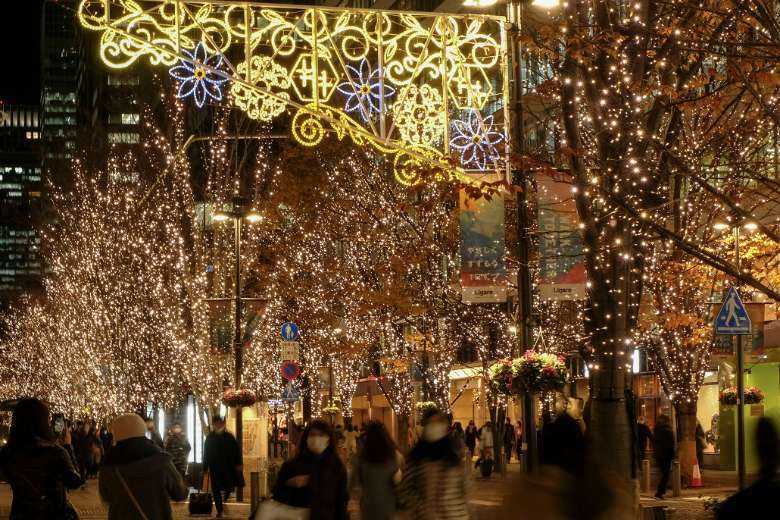
People walk under winter-themed illuminations, lit by about 1.2 million 'champagne gold' LED lights, as part of seasonal decorations in the Marunouchi business district of Tokyo on Dec. 21. (Photo: AFP)
What makes Christmas in Japan so unique? Faith has no place in it.
Being a secular holiday is not only a time for the usual shopping spree but also a special day for couples to go on a date. A dinner at a luxury French restaurant will be followed by a walk through the “illumination” sites, which are spectacular Christmas lights. They call them the kurisumasu irumineshon, and often in the background, a famous jingle is the Koibito ga Santa kurousu (My lover is Santa Claus).
These spots become the set of real tourist pilgrimages — even in times of pandemic — in search of the most beautiful or most extravagant arrangement. It doesn't take a lot of effort to spot them as they are scattered everywhere through the urban landscape, especially near the hundreds of train stations that are the dynamic centers of a metropolis like Tokyo.
After the “illumination walk,” the couple will most likely spend the night in a way-in-advance-reserved hotel room.
There are evenings expressly organized for the notoriously large number of singles who, on the night of Christmas Eve, find themselves without a partner. The Christmas konkatsu goes even one step further as the participants engage in rationally organized parties for the express purpose to find a potential marriage partner. And anyone looking for a soulmate better reserve a seat weeks ahead as they tend to get filled pretty quickly.
Over the years the “Christmas date” has become such a popular custom — it is the second most participated event after the New Year celebrations — that it gave rise to an urban myth: the big number of suicides committed at Christmas due to the breaking of the promise for a romantic dinner on that day.
Just like when the Japanese regularly celebrate weddings in what they call a seiyou-shiki or Western style (which would be more appropriate to define as a Christian one, as it not only involves a quasi-replica of the inside of a church but also the presence of an actor impersonating a priest), so Christmas is only aesthetically reproduced to create a sense of celebration without the demanding load of religious tradition.
All in all, there is nothing like Christmas in Japan to unleash a collective frenzy of romance, and that is somewhat ironic given that in the past celebrating this holiday in the Land of the Rising Sun was an incontrovertible mark of illicit conduct that called for the most horrible punishments, a wicked practice that lasted for more than 200 years.
Christmas was celebrated in Japan for the first time during the Sengoku Jidai, or Warring States era, in the 16th century when the most heroic Christian missionaries after perilous journeys through pirate-infested seas first arrived here in the confident hope of converting nothing less than the whole archipelago.
For a brief moment, the legendary Francis Xavier did seem to meet the stratospherically high expectations, succeeding in converting hundreds of thousands to the new faith, before the two-century ban on the religion forced Christians to hide, out of fear for their very lives.
The celebration of modern Christmas took place in Japan only at the end of the 19th century during the Meiji Restoration when the ban was finally lifted and the country opened up to the West after a long and self-imposed isolation.
As the end of the year gets closer, the Japanese prepare to celebrate the shougatsu and consume the osechi, a special box with traditional food, mostly vegetables, and fish.
This is also the time of the year when the lowest number of suicides are recorded. And this is not an urban myth.
What happens during these days? Everyone, absolutely everyone, returns to their native homes (jikka) to celebrate the New Year.
It is remarkably obvious to note that by maintaining a close connection to one's own family, the average Japanese is also actively engaging in the most successful therapy against any thoughts of desperation and unhappiness.
The views expressed in this article are those of the author and do not necessarily reflect the official editorial position of UCA News.


